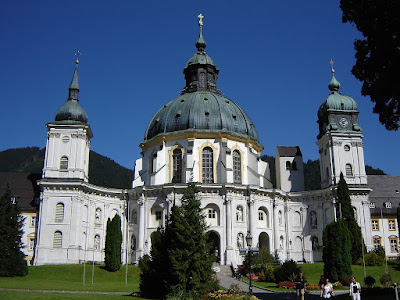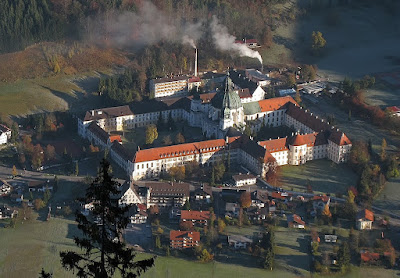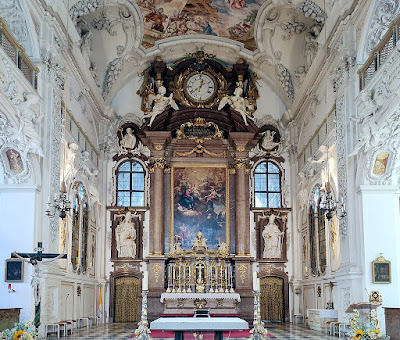Basilicas in Germany—Southern Bavaria
Basilica of St. Ann, Altotting
Declared a minor basilica by Pope Pius X in 1913.
Pilgrims have journeyed to Altotting since the 15th Century to honor Our Blessed Mother. This neo-Baroque church was completed in 1912 to accommodate larger numbers of pilgrims.
All pictures are from Wikipedia.
Basilica of Our Lady of the Assumption, Ettal
Declared a minor basilica by Pope Benedict XV in 1920.
A Benedictine monastery—Ettal Abbey—was established here in 1330 and a Gothic abbey church was built. The abbey was damaged during the Reformation but reached its prime in the 1700s. A fire destroyed much of the abbey and its church and they were rebuilt in a Baroque style. A school was also established. The abbey was closed in 1803 and was in private ownership until 1900 when it was returned to the Benedictines. The monastery continues to operate today. During the Second World War, the monastery housed prominent critics of the Nazi regime. Unfortunately, ten priests at the school were accused in 2010 of sexual abuse against male students at the monastery school and the monastery compensated the victims.
All pictures are from Wikipedia.
Basilica of St. Alexander and Theodor, Ottobeuren
Declared a minor basilica by Pope Pius XI in 1925.
Several abbey churches have been on this site since a Benedictine monastery was established in 764. The current Baroque church was built in the 18th Century. The basilica has three pipe organs, two of which date to 1766.
All pictures are from Wikipedia.
Basilica of St. Mauritius, Niederaltaich
Declared a minor basilica by Pope Pius XI in 1931.
A Benedictine abbey was established here in 741 and the current abbey church was built in a Baroque style in the first half of the 18th Century. The abbey was closed in 1803 but reopened in 1918. Pope Pius XI charged the monks in 1924 with making the theology and spirituality of the east known to the west. Therefore, the monks live and pray using both Roman and Byzantine rites.
All pictures are from Wikipedia.
Basilica of SS. Ulrich and Afra, Augsburg
Declared a minor basilica by Pope Pius XI in 1937.
A Benedictine monastery was built in the site in the 8th Century and the church is now named for Augsburg’s patron saints—Afra (a 4th Century martyr) and Ulrich (a 10th Century bishop). The current brick building was built in a Gothic style in the late 15th Century. The monastery was closed in 1802 and the building became the parish church in 1810. The church has Baroque and Romanesque details.
All pictures are from Wikipedia.
Basilica of the Assumption of Our Lady, Tuntenhausen
Declared a minor basilica by Pope Pius XII in 1942.
The church was originally part of an Augustinian monastery established in the 13th Century. After a miracle was reported in 1441, pilgrims started coming in great numbers. The church was expanded and was replaced by the current church in 1630. The church was closed in 1803 by the secularization decree. It reopened later in the 19th Century.
All pictures are from Wikipedia.
Basilica of St. Michael, Altenstadt
Declared a minor basilica by Pope Paul VI in 1965.
The church was built between 1180 and 1220 as a parish church. The Romanesque building contains frescoes and a baptismal font dating to the time of its construction.
All pictures are from Wikipedia.
Basilica of St. Lawrence and Our Lady of the Assumption, Kempten
Declared a minor basilica by Pope Paul VI in 1969.
A Benedictine monastery was built here in the 8th Century. The current church was built in a Baroque style in the mid-1600s after the previous church (and monastery) were destroyed during the Thirty Years’ War.
All pictures are from Wikipedia.
Basilica of St. Benedict, Benediktbeuern
Declared a minor basilica by Pope Paul VI in 1972.
The church was built in the 17th Century as an abbey church for a Benedictine monastery. It was built in an Italian Baroque style and is decorated with stucco and frescoes. The pipe organ dates to the late 17th Century.
The first picture is from a local source and the rest are from Wikipedia.
Basilica of the Assumption of Our Lady and the Holy Cross, Scheyern
Declared a minor basilica by Pope John Paul II in 1979.
The Romanesque church was built as a parish and Benedictine abbey church in the 13th Century. The monastery closed in 1803. The church is decorated with stucco and frescoes.
All pictures are from Wikipedia.
Cathedral Basilica of SS. Peter and Paul, Dillingen
Declared a minor basilica by Pope John Paul II in 1979.
This church is the co-Cathedral for the Diocese of Augsburg. The church was constructed between 1619 and 1628 to replace an earlier church. The church sustained damage during the Thirty Years’ War and was restored in 1643.
The first picture is from a local source and the rest are from Wikipedia.
Basilica of St. Margaret, Osterhofen-Altenmarkt
Declared a minor basilica by Pope John Paul II in 1982.
Osterhofen Abbey was established in the 11th Century. The current Baroque church was built between 1726 and 1740 as an abbey church.
The first picture is from a local source and the rest are from Wikipedia.
Basilica of St. Martin and St. Kastulus, Landshut An Der Isar
Declared a minor basilica by Pope John Paul II in 2001.
The Gothic collegiate church was built between 1385 and 1500 to replace an earlier church. The tower rises almost 430 feet and is thought to be the tallest brick tower in the world. The church has a main altar dating to 1424, a stone pulpit from 1429 carved from a single stone, a 26-foot-tall crucifix from 1495 with a corpus carved from a lime tree trunk, and a Baroque organ façade from 1625.
All pictures are from Wikipedia.





































































No comments:
Post a Comment